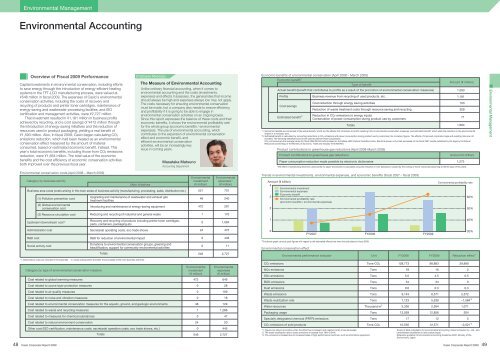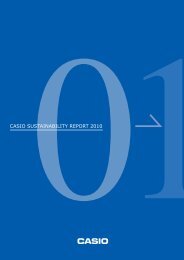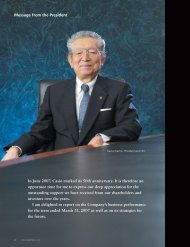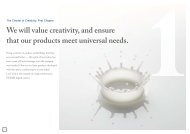Casio Computer Co. Ltd
Corporate Report 2009 all pages - Casio
Corporate Report 2009 all pages - Casio
- No tags were found...
You also want an ePaper? Increase the reach of your titles
YUMPU automatically turns print PDFs into web optimized ePapers that Google loves.
Environmental Management<br />
Environmental Accounting<br />
Overview of Fiscal 2009 Performance<br />
Capital investments in environmental conservation, including efforts<br />
to save energy through the introduction of energy-efficient heating<br />
systems in the TFT-LCD manufacturing process, were valued at<br />
¥546 million in fiscal 2009. The expenses of <strong>Casio</strong>’s environmental<br />
conservation activities, including the costs of recovery and<br />
recycling of products and printer toner cartridges, maintenance of<br />
energy-saving and wastewater processing facilities, and ISO<br />
certification and management activities, were ¥2,727 million.<br />
That investment resulted in ¥1,181 million in business profits<br />
achieved by recycling, and a cost savings of ¥412 million through<br />
the introduction of energy-saving initiatives and the reduction of<br />
resources used in product packaging, yielding a real benefit of<br />
¥1,593 million. Also, in fiscal 2009, <strong>Casio</strong> began calculating CO2<br />
emissions reduction, which had been treated as an environmental<br />
conservation effect measured by the amount of material<br />
consumed, based on estimated economic benefit, instead. This<br />
year’s total economic benefits, including those from CO2 emissions<br />
reduction, were ¥1,664 million. The total value of the economic<br />
benefits and the cost efficiency of economic conservation activities<br />
both improved over the previous fiscal year.<br />
Employee Message<br />
The Measure of Environmental Accounting<br />
Unlike ordinary financial accounting, when it comes to<br />
environmental accounting and the costs (investments,<br />
expenses) and effects it assesses, the general idea that income<br />
should always be high and expenses always low may not apply.<br />
The costs necessary for ensuring environmental conservation<br />
must be made, but a company also needs to ensure efficiency<br />
and profitability if it is going to be able to engage in<br />
environmental conservation activities on an ongoing basis.<br />
Since this report expresses the balance of these costs and their<br />
economic benefits, it shows the environmental profitability rate<br />
for the whole group (economic benefits / environmental<br />
expenses). The use of environmental accounting, which<br />
contributes to the expansion of environmental conservation<br />
effect and economic benefit, and<br />
efficient environmental conservation<br />
activities, will be an increasingly key<br />
issue in coming years.<br />
Masataka Matsuno<br />
Accounting Department<br />
Economic benefits of environmental conservation (April 2008 – March 2009)<br />
Economic benefit *1<br />
Actual benefit (benefit that contributes to profits as a result of the promotion of environmental conservation measures)<br />
Profits<br />
<strong>Co</strong>st savings<br />
Estimated benefit *2<br />
Totals<br />
Type of benefit<br />
Business revenue from recycling of used products, etc.<br />
<strong>Co</strong>st reduction through energy saving activities<br />
Reduction of waste treatment costs through resource saving and recycling<br />
Reduction in CO2 emissions to energy inputs<br />
<strong>Co</strong>nservation of power consumption during product use by customers<br />
Amount (¥ million)<br />
*1. Economic benefits are comprised of the actual benefit, which are the effects that contribute to profits resulting from environmental conservation measures, and estimated benefit, which state the reduction in the environmental<br />
impact in a monetary sum.<br />
*2. Estimated benefit is calculated by converting reductions in CO2 emissions and power consumption during product use by customers into monetary figures. The effects of improved corporate image and avoiding risks are not<br />
included. The following statistical sources are used to perform these calculations:<br />
CO2 unit prices are the average values for fiscal 2008 (¥2,531.6/ton) based on the Nikkei-JBIC Carbon Quotation Index. Electrical power unit prices are based on the fiscal 2007 results published by the Agency for Natural<br />
Resources and Energy of the Ministry of Economy, Trade and Industry (¥15.90/kWh).<br />
Product contributions to greenhouse gas reductions (April 2008-March 2009)<br />
Product contributions to greenhouse gas reductions<br />
Paper consumption reduction made possible by electronic dictionaries<br />
1,593<br />
1,181<br />
103<br />
309<br />
71<br />
1,664<br />
Amount (¥ million)<br />
*The effect of substituting electronic dictionaries for paper dictionaries is calculated using the reduction in CO2 absorption caused by the cutting of forest resources (assuming a tree life span of 50 years).<br />
1,273<br />
Environmental Management<br />
Environmental conservation costs (April 2008 – March 2009)<br />
Category by business activity<br />
Main initiatives<br />
Business area costs (costs arising in the main areas of business activity (manufacturing, processing, sales, distribution etc.)<br />
(1) Pollution prevention cost<br />
(2) Global environmental<br />
conservation cost<br />
(3) Resource circulation cost<br />
Upstream/downstream cost *2<br />
Administration cost<br />
R&D cost<br />
Social activity cost<br />
Category by type of environmental conservation measure<br />
<strong>Co</strong>st related to global warming measures<br />
<strong>Co</strong>st related to ozone layer protection measures<br />
<strong>Co</strong>st related to air quality measures<br />
<strong>Co</strong>st related to noise and vibration measures<br />
Upgrading and maintenance of wastewater and exhaust gas<br />
treatment facilities<br />
Introducing and maintenance of energy-saving equipment<br />
Reducing and recycling of industrial and general waste<br />
Recovery and recycling of products including printer toner cartridges,<br />
parts, containers, packaging etc.<br />
Secretariat operating costs, eco trade shows<br />
R&D for reduction of environmental impact<br />
Totals<br />
<strong>Co</strong>st related to environmental conservation measures for the aquatic, ground, and geologic environments<br />
<strong>Co</strong>st related to waste and recycling measures<br />
<strong>Co</strong>st related to measures for chemical substances<br />
<strong>Co</strong>st related to natural environment conservation<br />
Donations to environmental conservation groups, greening and<br />
beautification, support for community environmental activities<br />
*1. Depreciation costs are included in the expenses. *2. <strong>Co</strong>sts arising before and after the processes of the main business activities.<br />
Other cost (ISO certification, maintenance costs, secretariat operation costs, eco trade shows, etc.)<br />
Totals<br />
Environmental<br />
investment<br />
(¥ million)<br />
472<br />
0<br />
0<br />
0<br />
48<br />
1<br />
0<br />
24<br />
0<br />
546<br />
521<br />
48<br />
472<br />
1<br />
0<br />
24<br />
0<br />
0<br />
546<br />
Environmental<br />
investment<br />
(¥ million)<br />
Environmental<br />
expenses *1<br />
(¥ million)<br />
701<br />
240<br />
291<br />
170<br />
1,094<br />
475<br />
446<br />
11<br />
2,727<br />
Environmental<br />
expenses<br />
(¥ million)<br />
646<br />
28<br />
109<br />
18<br />
129<br />
1,286<br />
47<br />
20<br />
445<br />
2,727<br />
Trends in environmental investments, environmental expenses, and economic benefits (fiscal 2007 - fiscal 2009)<br />
Amount (¥ billion)<br />
4<br />
Environmental investment<br />
Environmental expenses<br />
Economic benefit<br />
3<br />
Environmental profitability rate<br />
(economic benefits / environmental expenses)<br />
2<br />
1<br />
0<br />
Environmental conservation effect<br />
CO2 emissions<br />
NOx emissions<br />
SOx emissions<br />
BOD emissions<br />
Dust emissions<br />
Waste emissions<br />
Waste reutilization rate<br />
Water resources<br />
Packaging usage<br />
Environmental performance indicator Unit<br />
FY2008<br />
FY2009 Reduction effect *1<br />
Specially designated chemical (PRTR) emissions<br />
CO2 emissions of sold products<br />
FY2007 FY2008 FY2009<br />
*The above graph corrects past figures with regard to the estimated effects that were first calculated in fiscal 2009.<br />
*1. Figures are shown as positive when the effect has increased, and negative when it has decreased.<br />
*2. The waste reutilization rate to waste emissions increased from 78% to 84%.<br />
*3. CO2 emissions increased due to increased sales of high-performance machines, such as information equipment.<br />
Tons-CO2<br />
Tons<br />
Tons<br />
Tons<br />
Tons<br />
Tons<br />
Tons<br />
Thousand m 3<br />
Tons<br />
Tons<br />
Tons-CO2<br />
128,773<br />
18<br />
5.0<br />
34<br />
0.6<br />
9,143<br />
7,123<br />
3,336<br />
13,059<br />
17<br />
10,550<br />
98,883<br />
16<br />
4.5<br />
34<br />
0.3<br />
6,571<br />
5,539<br />
2,264<br />
12,856<br />
12<br />
12,571<br />
Environmental profitability rate<br />
48 <strong>Casio</strong> <strong>Co</strong>rporate Report 2009 <strong>Casio</strong> <strong>Co</strong>rporate Report 2009 49<br />
29,890<br />
2<br />
0.5<br />
0<br />
0.3<br />
2,572<br />
–1,584 *2<br />
1,071<br />
204<br />
60%<br />
50%<br />
40%<br />
30%<br />
5<br />
–2,021 *3<br />
Scope of data compilation for environmental accounting: <strong>Casio</strong> <strong><strong>Co</strong>mputer</strong> <strong>Co</strong>., <strong>Ltd</strong>., and<br />
consolidated subsidiaries in and outside Japan.<br />
Reference guideline: Environmental Accounting Guidelines 2005, Ministry of the<br />
Environment, Japan







